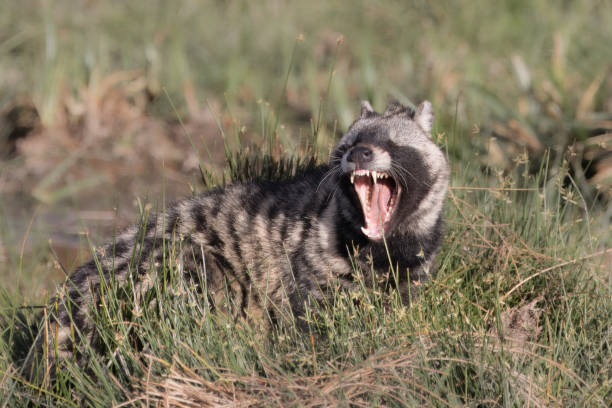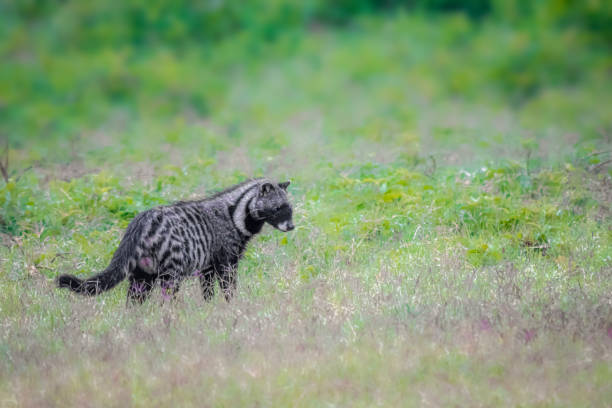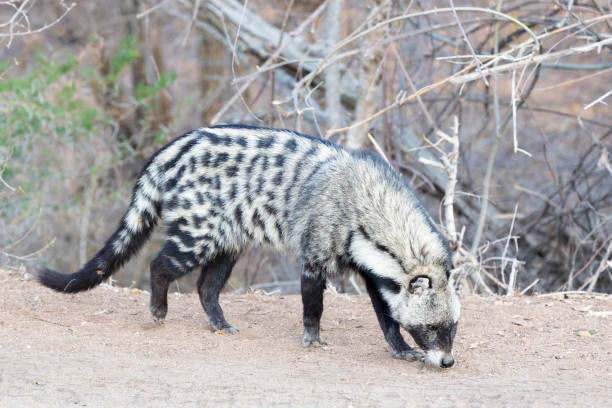Table of Contents
Scientific Classification
| Kingdom | Animalia |
| Phylum | Chordata |
| Class | Mammalia |
| Order | Carnivora |
| Family | Viverridae |
| Genus | Civettictis |
| Species | Civettictis civetta |
| Scientific Name | Civettictis civetta |
Description
The African Civet (Civettictis civetta) is a medium-sized mammal known for its nocturnal habits and distinctive black and white fur. Its face is adorned with mask-like markings, and it has an elongated body, making it one of the largest members of the Viverridae family.
African Civets possess sturdy bodies characterized by a sloping back and short legs. Their fur is typically coarse and thick, featuring a mix of black, gray, and white spots or stripes that aid in camouflage. A prominent black stripe runs down their back, and their facial markings resemble those of raccoons due to the dark patches around their eyes. They can reach lengths of up to 85 cm (33 inches), with an additional tail measuring about 40 cm (16 inches), and they typically weigh between 7 to 20 kg (15 to 44 lbs).

Distribution
The African Civet is found throughout sub-Saharan Africa, inhabiting over 30 countries, including:
Nigeria
Kenya
South Africa
Uganda
Cameroon
This versatile species thrives in various environments, such as forests and savannas, making it one of the most widely distributed small carnivores on the continent.
Habitat
African Civets prefer areas with abundant vegetation and water sources, such as:
- Tropical rainforests – Providing dense cover and food sources.
- Savannas and grasslands – Open landscapes where they can hunt small prey.
- Woodlands and scrublands – Offering a mix of cover and hunting grounds.
- Wetlands and riverbanks – Where they find additional food resources.
They are very adaptable, but they avoid deserts and open plains. These areas lack cover.
Diet
The African Civet is an omnivore, which means it eats a wide range of foods, such as:
Small mammals and birds – This includes rodents, reptiles, and insects.
Fruits and berries – A major component of their diet, particularly figs and bananas.
Invertebrates – They consume beetles, crickets, and caterpillars.
Carrion – They will eat the remains of dead animals when they can find them.
Eggs – They often take eggs from bird nests.
This varied diet helps them thrive in different habitats.
Behavior
- Nocturnal Lifestyle – African Civets are mostly active at night. They rest in thick plants during the day.
- Solitary Nature – They are mostly solitary, except during mating or when rearing young.
- Scent Marking – They use musky secretions from perineal glands to mark their territory.
- Climbing Ability – They mostly stay on the ground, but they can climb trees to escape danger or find food.
- Vocal Communication – They make growls, hisses, and purring sounds to communicate.

Lifespan
In the wild, African Civets live about 15 to 20 years. In captivity, they often live longer. This is because they have no predators and always have food.
Reproduction and Lifecycle
- Breeding Season – Varies depending on location but often occurs in the wet season.
- Gestation Period – Lasts 60 to 70 days.
- Litter Size – 1 to 4 cubs per birth.
- Parental Care – Mothers care for their young by nursing and protecting them in hidden dens.
- Independence – Cubs begin foraging at around 6 months and reach maturity at 1 year.
Predators
African Civets have sharp claws and teeth for defense. However, they are hunted by larger predators.
- Lions – Occasionally hunt civets when other prey is scarce.
- Leopards – One of their primary natural predators.
- Hyenas – Opportunistic hunters that target civets, especially young ones.
- Snakes – Large pythons may consume civets if given the chance.
- Humans – Civets are hunted for their musk, which is used in perfumes.

Adaptations
The African Civet has evolved several adaptations for survival:
- Camouflaged Fur – Their spotted and striped fur helps them blend into the environment.
- Strong Sense of Smell – Used for detecting food and marking territory.
- Sharp Claws and Teeth – For catching prey and self-defense.
- Musky Secretion – Used for communication and deterring predators.
- Nocturnal Vision – Adapted for hunting in low-light conditions.
Conservation Status
Current Status: Least Concern (IUCN)
African Civets are losing their habitats and facing hunting threats. Still, their wild population stays stable. However, they face several threats:
Threats:
- Deforestation – Destroying their natural habitat.
- Hunting for Musk – Historically used in the perfume industry.
- Human Encroachment – Leading to increased conflict.
Conservation Efforts:
- Protected Reserves – Ensuring safe habitats for civets.
- Legal Protection – Hunting bans in some regions.
- Sustainable Practices – Reducing deforestation and promoting eco-tourism.
Conclusion
The African Civet is a fascinating night animal. It helps keep nature balanced by being both a predator and a scavenger. Even with human threats, their adaptability helps them survive in Africa. With continued conservation efforts, the future of these unique creatures remains hopeful



